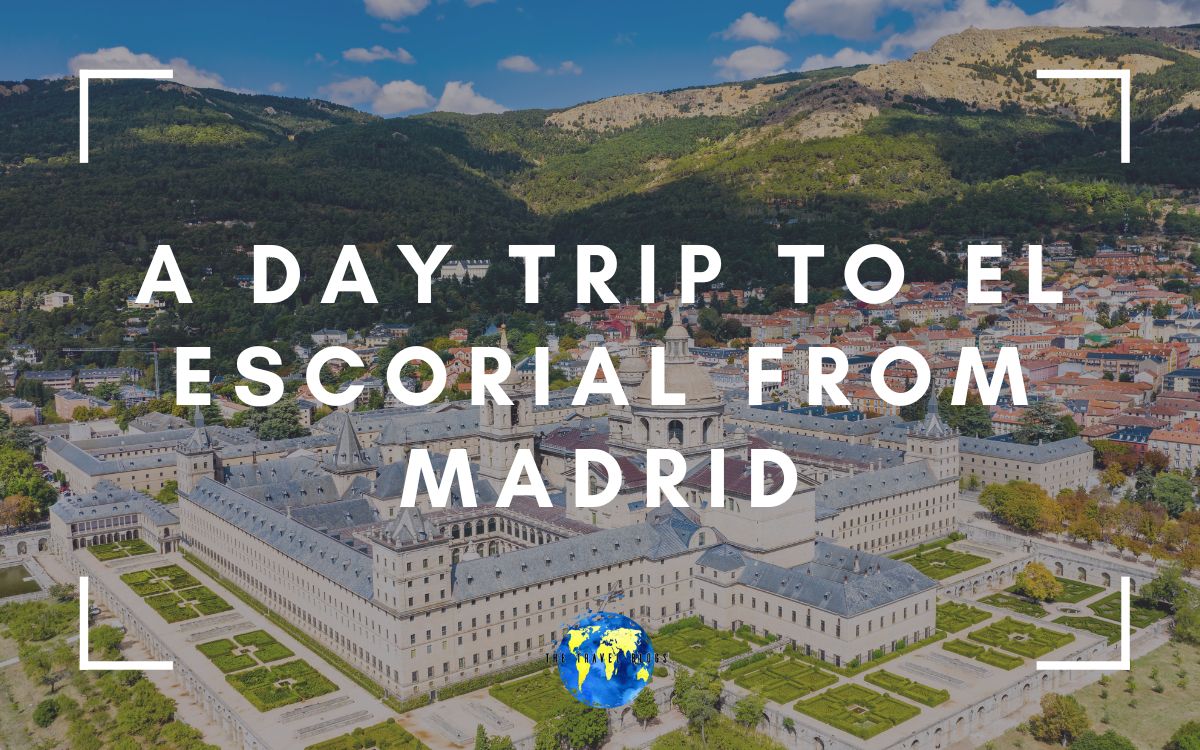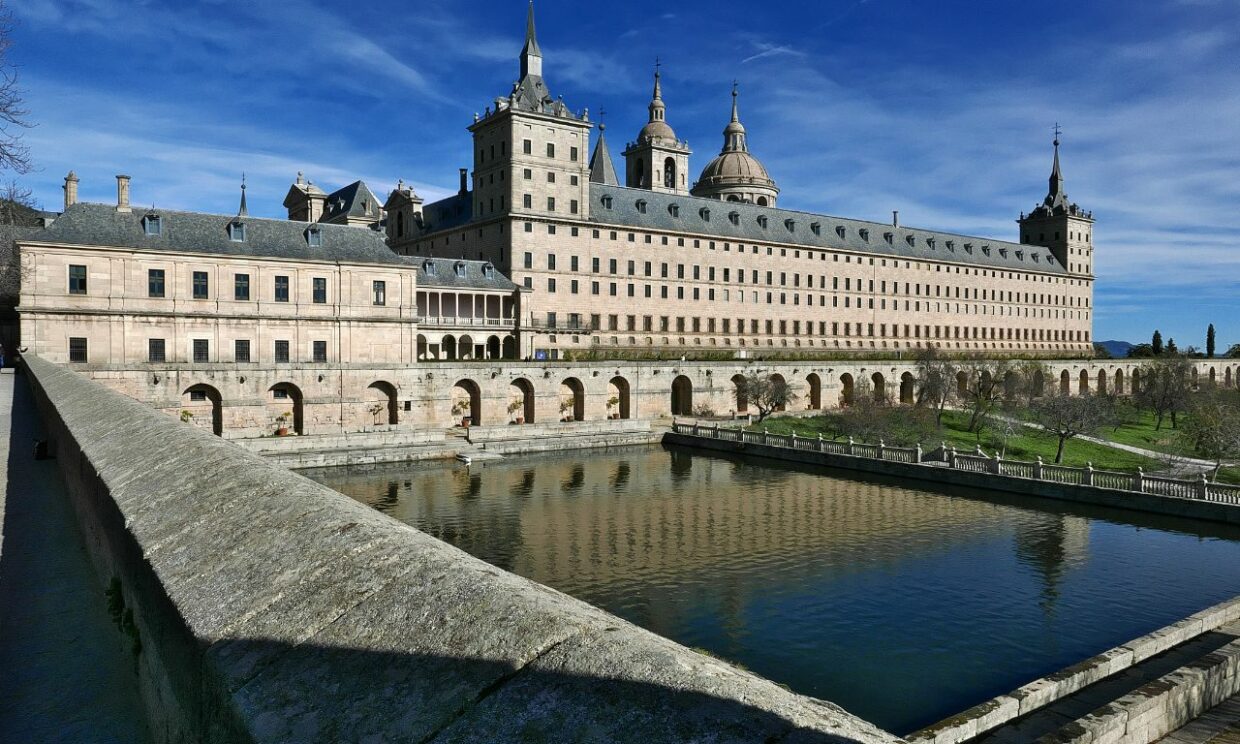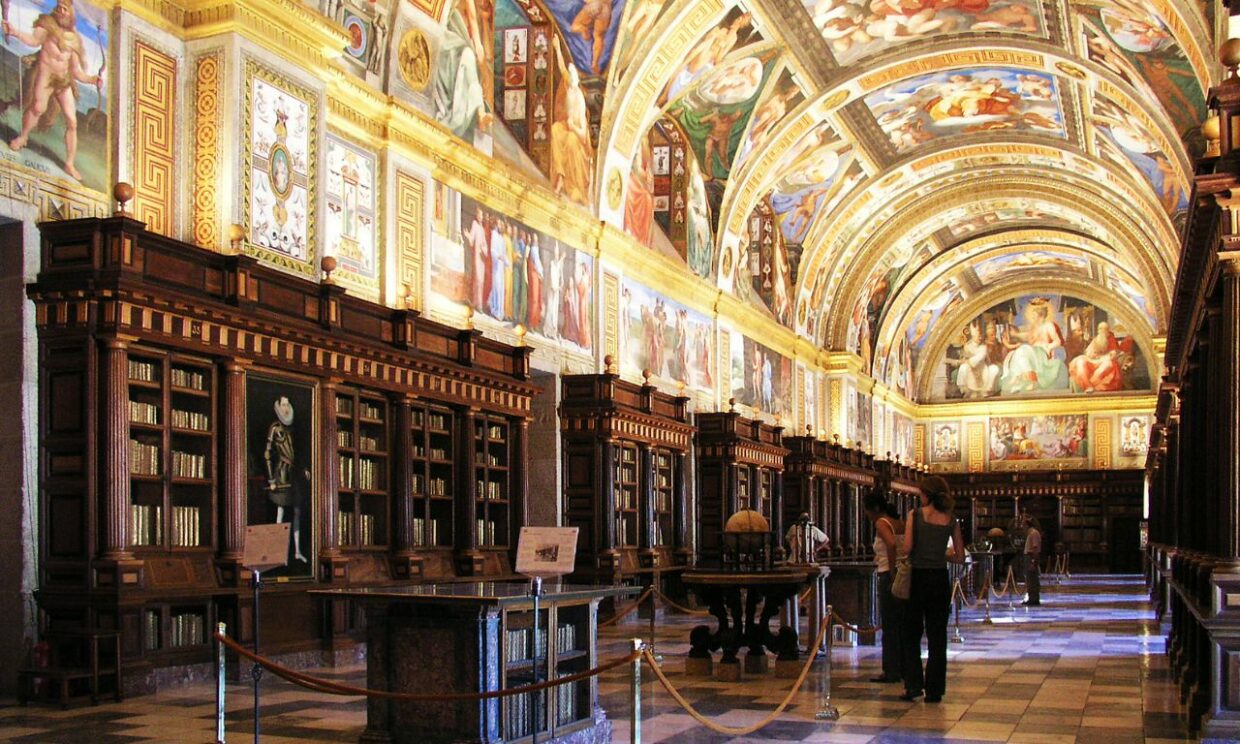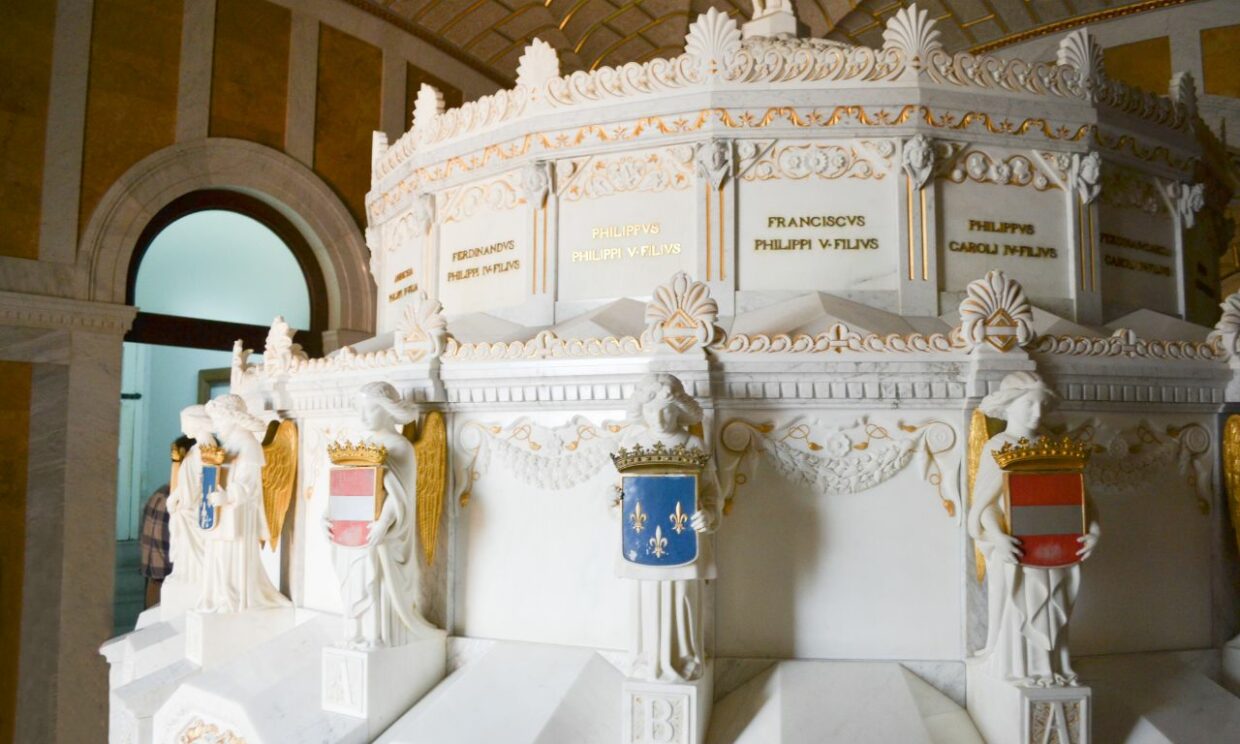A Spanish treasure located approximately 50km northwest of Madrid is the town of El Escorial. Whether you are a nature lover, gastronome, or history enthusiast, San Lorenzo de El Escorial has plenty of things to delve into.
The most popular site people visit here is the Royal Monastery of El Escorial. An impressive UNESCO World Heritage site that is the final resting place for many iconic Kings and Queens throughout Spain’s history.
In this post, I’ll help you decide if you should take a day trip to El Escorial from Madrid, complete with my guide on how you can get there and the best things to see and do when you visit.
So, gear up!
Sad side note: I lost most of the photos of my visit, so I have had to patch together some stock photos and borrowed ones for this post. I’ll fix this when I go back.
Coming your way in this post - click to expand ->
Note – Please know, some of the external links on this page are affiliate links, this means that if you purchase after following one, I make a small commission from the sale at no additional cost to yourself.
Is El Escorial worth visiting?
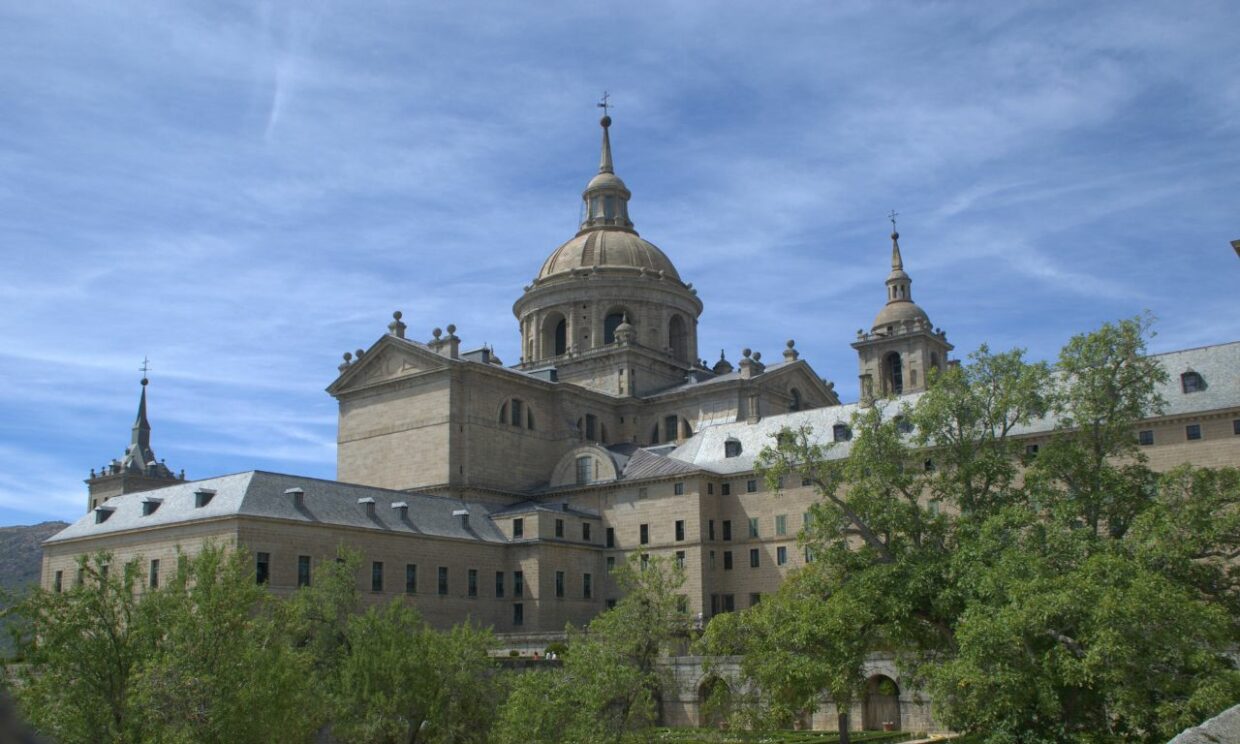
Yes, El Escorial is definitely worth visiting. It has a wealth of history and culture to explore, surrounded by the beautiful natural scenery of the region.
The monastery is a stunning example of Spanish Renaissance architecture, built in honour of Philip II by Juan Bautista de Toledo. Visitors can explore the elegant basilica inside and the palace and pantheon for Spanish royalty. Many come to admire one of Europe’s finest art galleries, which houses some incredible works ranging from classical masterpieces to more modern pieces.
Outside of the monastery, there are plenty of other things to enjoy. For nature lovers there are several parks and gardens where you can soak up some peace and quiet away from the hustle and bustle of city life. Hiking trails make it easy to explore these areas with some great views back towards the monastery.
Foodies will be pleased to know that El Escorial takes its culinary heritage seriously too – from traditional Castilian dishes to more contemporary cuisine – there’s something to please all tastes here.
In short, El Escorial offers something for everyone – from its stunning architecture and art galleries to its tranquil natural surroundings – making it an ideal day trip destination for people looking for an escape from Madrid without travelling too far away!
Check out this free walking tour, a great idea if you decide to visit for a day.
How to get from Madrid to El Escorial
There are a few choices when traveling between Madrid and El Escorial. You can opt for the Bus if you want to save money or the train is a bit more comfortable but costs a little more. If you don’t fancy public transport, you can also go by car if you want flexibility or favour an easy life; many tours will even pick you up from your hotel.
Here’s a quick overview of your options for 1 day in el escorial.
Drive
As always, driving is the most convenient option. The easiest route to drive to El Escorial from Madrid is to take the A6 motorway out of the city, head north, then take exit 47 towards El Escorial. This should take a little under an hour.
My preferred route is to take the M-503 out of the city, then at Villanueva de la Cañada, join the M-600. It is a little more scenic and less hectic than the motorway and is only a few minutes longer in time.
Once you are in El Escorial, there are plenty of car parks so you won’t have to worry about where to leave your car.
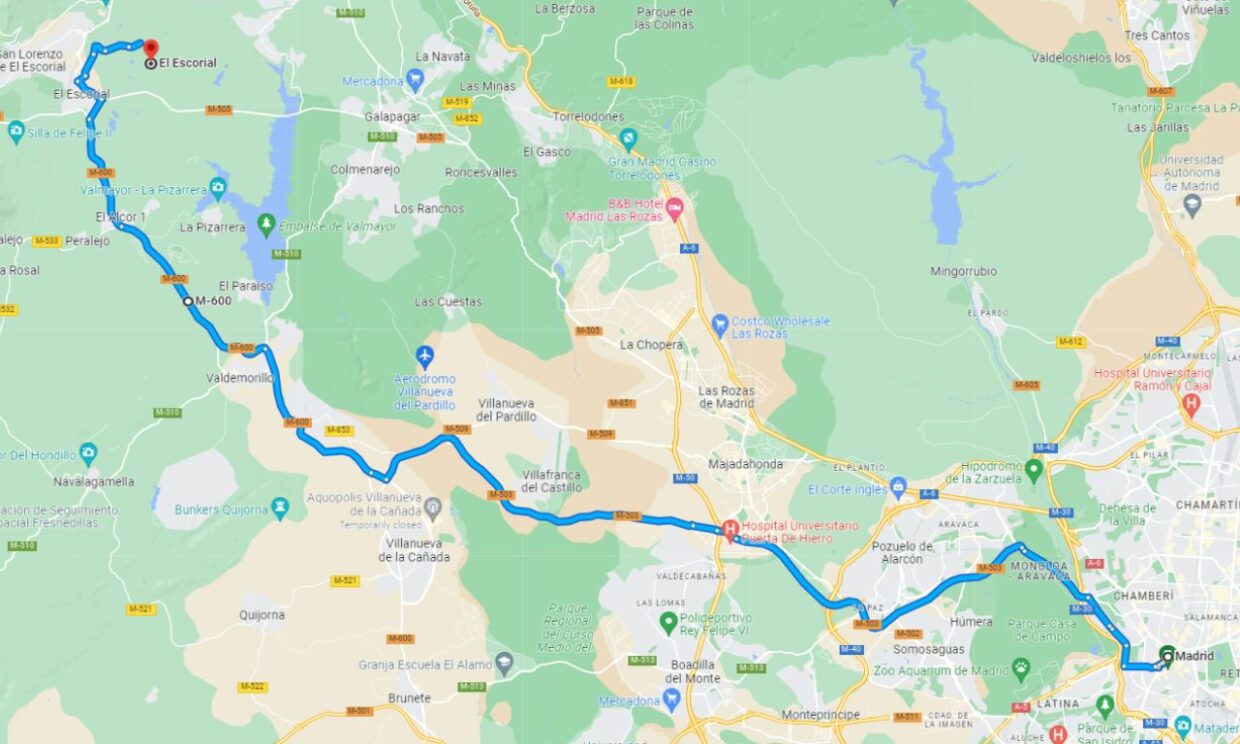
By Train
To travel by train to El Escorial from Madrid, you can take the Cercanias C-3 line. The Tren de Cercanías RENFE (simply “Cercanías” to locals) is the name of the above ground city transit trains. There is also a Metro which is the underground ones.
The best stations to catch the Cercanias El Escorial train services from Madrid are Atocha station, Nuevos Ministerios, or Chamartin station. They will cost you €17.40 for a return ticket and can be purchased on arrival at the station. You can use the ticket machines to buy them, just look for El Escorial as your destination.
If you have any questions, or are unsure, you can go to one of the ticket widows to purchase as well. While it will be a bit hit or miss on the chances of the ticket sales person speaking fluent English, there is a good chance they will speak enough fo you to buy your ticket without problems.
Something it’s good to know is when you get to El Escorial station, there is about a 25 minute walk into the town but there will be taxis and probably tuk tuks available if you don’t fancy it. Its a nice walk through a park, so it can be enjoyed as part of the trip.
By Bus
The cheapest way to get to San Lorenzo de el Escorial is by bus. Both routes 664 and 661 go to the town and take around an hour. The El Escorial bus services leave from Moncloa which you can reach via Metro on both line 3 or line 6. The bus costs around €7-€10.
The bus stops at the Juan de Toledo bus station located in the heart of the town, close to the Monestary by the Parque Juan Herrera.
Book a Guided Day Trip
Taking a guided tour from Madrid to San Lorenzo de El Escorial has many benefits over organizing your own day trip by train or bus. You get an experienced, knowledgeable guide who can take you directly to all the essential landmarks in San Lorenzo de El Escorial and provide interesting historical facts and anecdotes along the way. Moreover, with a guided tour, you ensure that everything runs smoothly and efficiently, compared to traveling independently, which can be unpredictable at times.
You can simply sit back and relax while your guide does all the work for you. Additionally, you will save time when it comes to researching attractions around San Lorenzo de El Escorial or figuring out possible transit routes; this is especially true if you are pressed for time.
Half-day tours will usually include a visit to The Valley of the Fallen (more on that later in this post) or you could consider a full-day option that includes a visit to Segovia.
However … it will be the most expensive option, so if you are on a tight budget, it would be best to stick with self-serve. However, this is a great option when you are tight on time, or you’re feeling a little lazy!
Recommended day tours from Madrid to El Escorial
Visiting The El Escorial Monastery
El Escorial Monastery is the main attraction people visit the town of San Lorenzo de El Escorial to see. Located northwest of Madrid, Spain, this site is a UNESCO World Heritage site and one of Europe’s most important historical sites. It was built between 1563 and 1584 by King Philip II as a royal palace, monastery and mausoleum for his family members. This majestic building can be seen from miles away and it stands out as an impressive symbol of Spain’s long history.
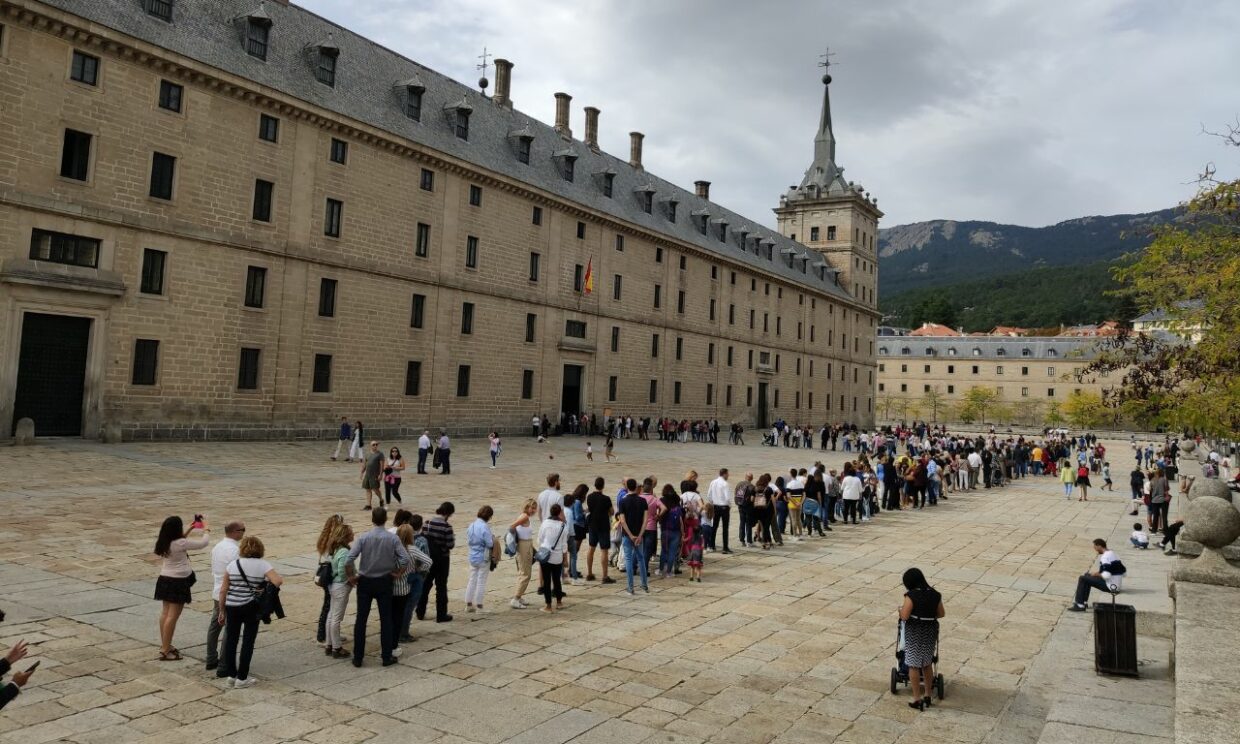
A visit to El Escorial offers an insight into the Renaissance period with its grand architecture that intertwines religious belief, politics, and aesthetics in a unique way. Its historical significance cannot be understated – it is an embodiment of Spanish culture that scholars and travelers have admired throughout time.
If you would rather relax and take it all in without the effort, I’d highly recommend booking a guided tour. This means you will not miss anything and will enjoy fun stories and factoids along the way.
Click here for more information about booking a tour.
Quick Info – El Escorial Monastery
El Escorial Opening Hours
- Summer, April to September: Open Tuesday to Sunday from 10am to 7pm
- Winter, October to March : Open Tuesday to Sunday from 10am to 6pm
Note: The Palace is always closed on Mondays and the following Spanish holidays: Jan 1, Jan 6, May 1, Sep 12, Dec 24, Dec 25, Dec 31.
El Escorial Monastery Prices
- Adult (17-64) €12
- Senior (65+) €6
- Youth (5-16) €6
- Child (0-4) Free
- Student with a valid student ID €6.60
You can buy tickets in advance to skip the queues. These can be downloaded and scanned from your mobile.
What not to miss inside El Escorial Monastery
The Museum
Once you enter El Escorial Monestary, the museum will be one of the first things you see. It’s definitely worth at least browsing through as it is a nice place to get a little bit of background and history before exploring deeper.
Inside the museum, you can find documents, building materials, and machinery used to construct this iconic monument. In addition to artifacts, displays explain various techniques used during erection, such as masonry and architectural styles like Gothic and Renaissance. The Architecture Museum also offers special exhibitions and educational programs to help deepen your appreciation of El Escorial’s history.
The Royal Pantheon
The Pantheon of Kings is a stunning circular chamber located in the heart of El Escorial. Covered half in orange marble and bronze, it oozes opulence and holds it a solemn yet captivating atmosphere.
Its circumference is segmented into eight sections, and the sixteen urns placed around the altar are where the remains of kings and their wives are kept – all in all, twenty-four Spanish monarchs have been interred here since its completion in 1654.
At the center of the Pantheon stands an imposing altar presided over by a crucifixion scene sculpted by Domenico Guidi. His work is considered to be one of the finest pieces at El Escorial, due to its intricate details and skilled craftsmanship.
It is definitely a room that you must not miss.
The Royal Library
Another room you have to see is the Royal Library. Founded by King Phillip II of Spain in the 16th century, was one of the first libraries to incorporate aspects from both the humanities and sciences. This new emphasis on knowledge and education was reflective of the spirit of the Renaissance and influenced how other libraries around the world would go about displaying their collections.
The huge main room is 55 meters long and 10 meters wide with the frescoes painted by Pellegrino Tibaldi between 1586 and 1592. Along the wall are seven large windows to the Patio de los Reyes and five to the Lonja creating a bright space.
The immense collection housed inside El Escorial houses over 400,000 texts and manuscripts on philosophy, politics, poetry and more, despite being decimated on numerous occasions, including a large fire in 1671.
However, as a travel lover, I really enjoyed the wide range of baroque globes and armillary spheres that King Phillip had avidly collected. I love looking at old maps and imagining what travel would have been like back then. Getting from A to B was probably not all that comfortable, but it must have been so exciting.
The Hall of Battles
The Hall of Battles at El Escorial is one of the largest and most impressive rooms in the palace. It originally bore the name of King’s Gallery (Galería del Rey) but came to be known as the Hall of Battles (Sala de Batallas) for its elaborate fresco paintings depicting some of Spain’s most iconic military feats.
When visitors arrived for an audience with King Philip II at the palace, they were forced to walk down the entire length of this awe-inspiring gallery in order to reach him. Its purpose was to illustrate to these guests just how powerful and successful Spain had become in defending its position on the world stage. The elaborate images that cover its walls tell stories of epic battles won, heroic feats and grand military triumphs that showcase Spanish courage and strength throughout history.
These include battles such as the medieval victory against the Moors or the numerous campaigns that took place during Philip II’s reign against his enemies from France.
The Basilica
The Basilica is the central building in the complex of the Monastery of El Escorial. This imposing structure was designed and built by Juan Bautista de Toledo, Phillip II’s chief architect, between 1563 and 1584e.
The basilica is divided into two churches—the Sotocoro (which served the town) and the Royal Chapel and Conventual Church which was reserved for members of the royal family.
The most striking feature of this church is its dome, inspired by the dome of St. Peter’s basilica in Rome. It stands nearly 100 metres (330 ft) high and is supported by four granite piers connected by Romanesque arches.
The Pantheon of Princes
The Pantheon of Princes, also known as the Panteón de Infantes is a tribute to the young princes who died without ascending to the throne.
Built-in 1888 by orders of Queen Isabel II, the Pantheon consists of nine chambers, all presided over by an altar and lined with beautiful marble sculptures.
The sculptures and decorative motifs were carved in Carrara by Jacopo Baratta di Leopoldo, a renowned artist who followed the models created by Ponciano Ponzano.
The interior is filled with light, thanks to its large windows that look out onto a beautiful courtyard filled with flowers and trees with inscriptions on the wall dedicated to princes who have passed away.
Other smaller highlights
- El Escorial Reflecting Pool – The reflecting pool of El Escorial is a popular spot for photos. It lies in the southwestern corner of the royal palace and (as the name suggests) in the right conditions, the monastery and its many windows are reflected in the rectangular pool.
- The Garden of the Friars – Hidden beside the awe-inspiring Monastery is a complex of beautiful gardens, accessible only by the side under an arch. It features breathtaking views of the nearby valley and its surrounding areas, making it the perfect spot to relax and unwind.
Other Top Things to do on an el Escorial day trip from Madrid
Enjoy a free walking tour
What better way to explore the town than a free walking tour? It all begins in Plaza de la Constitucion, where visitors can learn why the monastery was built in the 16th century. From there, you’ll visit some of the most important sites, such as the Coliseum of Charles III – one of the oldest covered theaters in Spain.
Along the journey, you’ll also get to enjoy views of Paseo de los Alamillos from friars’ gardens, as well as explore the many secrets held within Royal Monastery grounds.
Now, while it is officially a “free” walking tour, understand there is an expectation to tip the guide at the end, this is how they get paid. Free tours do not have a fixed price, rather each person offers the guide the amount they consider appropriate, depending on their level of satisfaction.
Click here for all the details about the walking tour
Go on a Hike
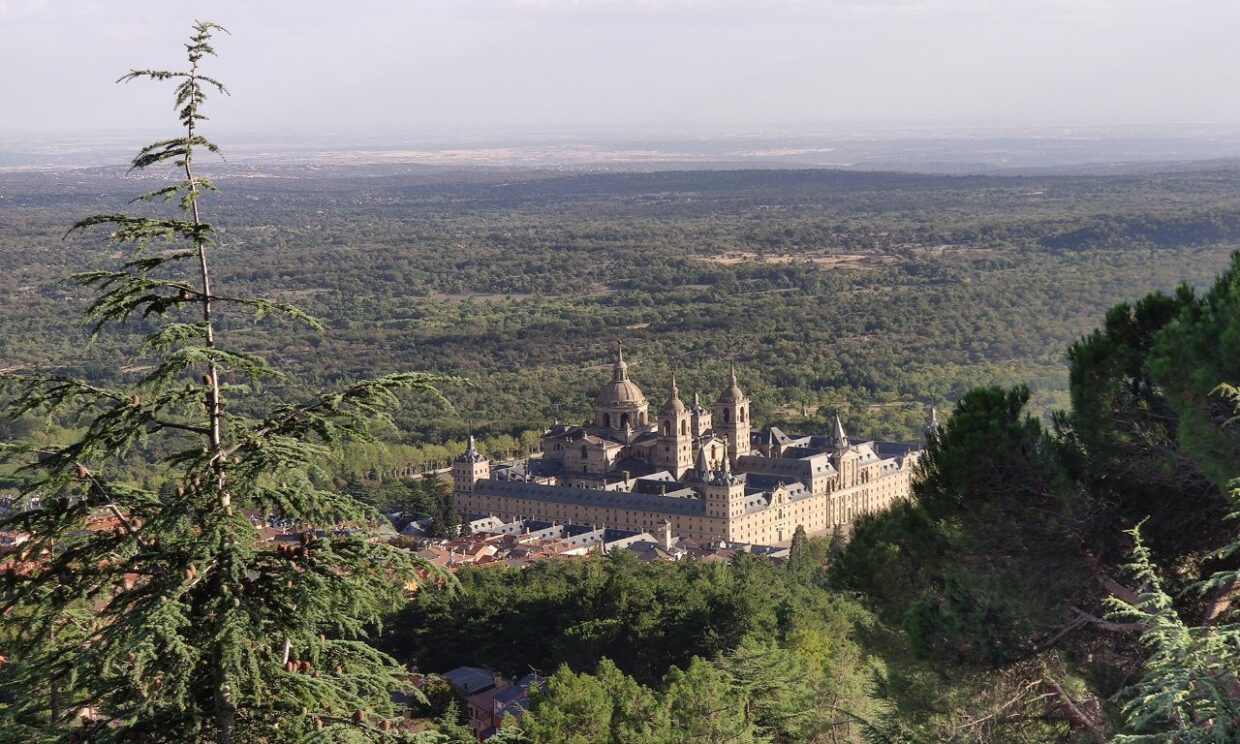
The royal monastery is situated in the heart of the splendid Sierra de Guadarrama mountains. There are plenty of well-maintained hiking routes and paths that will allow you to enjoy stunning views of the surrounding The El Escorial Monestary and the surrounding region.
You can try to reach The Chair of Philip II, a series of stepped platforms sculpted directly into granite. The chair itself stands out from the rest, with its four seats located on the north side.
Though it’s commonly thought that this was where Philip II came to supervise works at Monastery El Escorial, it has been suggested that the complex could actually be a sacrificial altar built by Vettones – a people who lived on Iberian Peninsula before Romans arrived.
This theory has since been debated among scholars and historians alike, with both sides presenting compelling evidence for their respective arguments.
El Bosque De La Herrería
The Herrería forest is home to diverse species of plants and animals and an escape from reality to the hustlers of life. The forest is also home to a small hermitage, Ermita del Virgen de Gracia. You can wander through the woodland, clouded with oak trees, and chestnut ash. It is a splendid spot throughout the year, no matter you visit in autumn or spring. You can enjoy lunch in the forest on picnic benches.
The Casita Del Principe
Designed by Juan de Villanueva, The Casita del príncipe is a stunning neoclassical cottage constructed for the private use of the heir to the Prince and Charles of Asturia, Maria Luisa. The building gives you a sneak peek of eighteenth-century Spanish architecture.
Located in the Parque y jardines de la Casita del Príncipe, it is a convenient place to visit when walking to or from the train station.
Cocheras del Rey Museum
The Cocheras del Rey – Collection is an exhibition located in the old Royal Coach House. It showcases the history, activities, and development of the royal buildings from 1771 to the late 1800s. Visitors to the exhibition can explore a variety of restored exhibits that illustrate how animals were used for transport prior to the Peninsular War. There are also detailed drawings and explanations that provide insight into life during this period of history. Furthermore, there are interactive displays that allow visitors to gain a hands-on experience in learning about how people used animal-powered transportation.
Also, consider the Civil War Monument – Valley of Fallen
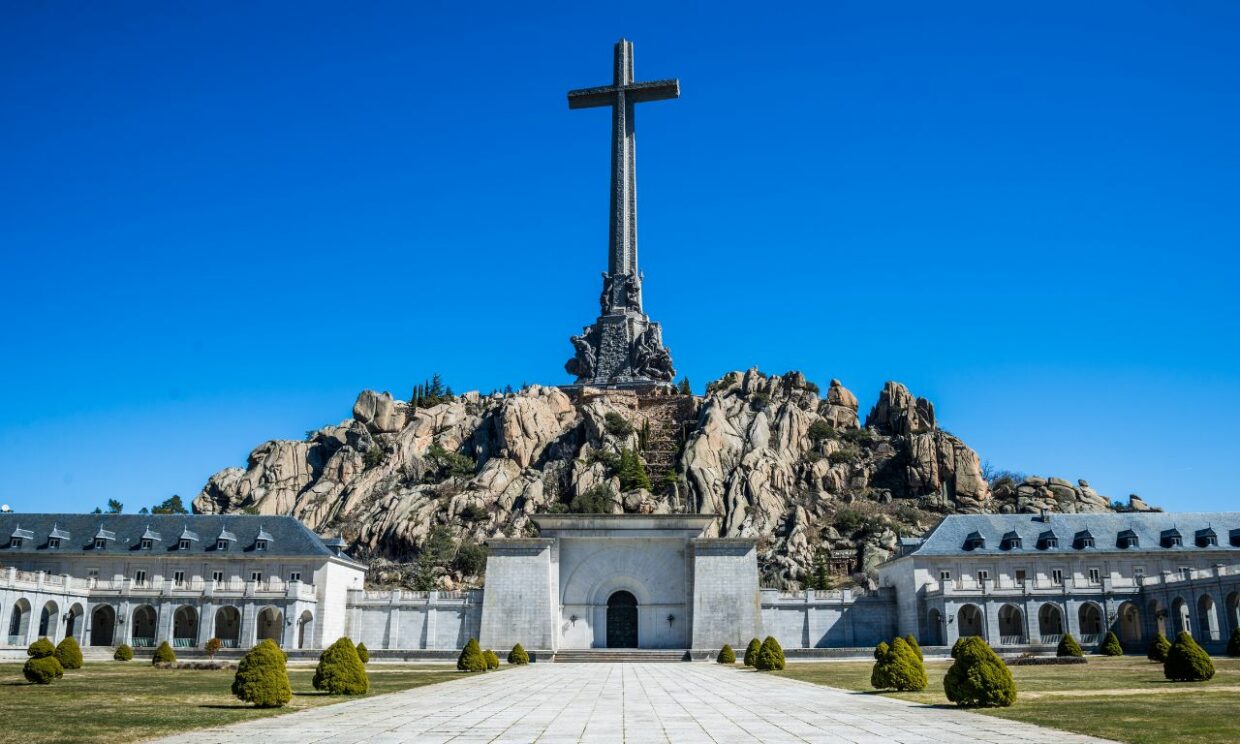
One of the Spain’s most controversial tourist attractions is The Valley of the Fallen (El Valle de los Caídos), intended as a burial site and memorial to those lost in the Spanish Civil War.
Under the orders of the Spanish dictator, Francisco Franco, construction began in 1940 and lasted for 18 years, finally finishing in 1959. It houses an underground basilica and the tombs within the Valley hold over 40,000 bodies of those who died during the war. The most striking feature is the enormous cross that towers 500 feet in the air and is visible from miles around.
When he passed in 1975, Franco himself was buried here, but his body has since been moved to a less controversial site.
The symbolism behind this project has been widely debated due to its authoritarian nature, seen by many as glorifying Franco’s regime. It has even become a kind of shrine for the far right in Spain and is loathed by many.
But, despite this controversy surrounding it, the Valley of the Fallen regularly attracts both tourists and protesters alike. In recent decades there have been calls to transform the Valley into a memorial against fascism, but so far, no action has been taken towards this end – leaving it open to interpretation and debate amongst visitors as they wander through its eerie depths today
Getting there
The Valley of the Fallen is a 15 minute drive from El Escorial. The is a bus service that runs once a day. It leaves at 3:15 pm and takes you right to the basilica. Be sure not to miss the return leg that leaves at 5:30 pm.
You’ll get a little over an hour at the site, which is plenty, and there is a €9 entrance fee for non-EU citizens.
If you want to visit on your own schedule, plenty of taxis or tours can be found in the town.
Hours
- Summer, April to September: Tuesday to Sunday from 10:00 to 7:00.
- Winter, October to March: Tuesday to Sunday from 10:00 to 6:00
- It is always closed on Mondays
FAQs
When is the best time to visit El Escorial?
Visiting El Escorial is best during either the spring or autumn months. The weather will be comfortable and, while busy, it will be a bit quieter than during peak visitor season. Whenever you do visit, try to get to the monastery early in the morning before the crowds.
What are the ticket prices for El Escorial Monastery?
The ticket prices start at €12. You can buy a ticket at the entrance if you don’t mind lines. Alternatively, you can book online before you go.
Is there any guided tour available?
How big is El Escorial Monastery?
It is among the largest religious establishments in the world at 675 by 528 feet which is 356,400 square feet (33,110 m²) or a little over 8 acres!
How long does it take to tour El Escorial?
The monastery is large, with a lot to take in. You could easily spend 4 hours exploring and learning the history of the site. If you have more of a passing interest. a couple of hours should be enough.
A Day Trip To El Escorial From Madrid – Final thoughts
All in all, El Escorial is a wonderful day trip destination from Madrid that has something for everyone. Whether you’re interested in culture and history or simply looking to escape the hustle and bustle of the city, El Escorial is the perfect place for you. We hope this article has inspired you to visit this Spanish treasure for yourself!
